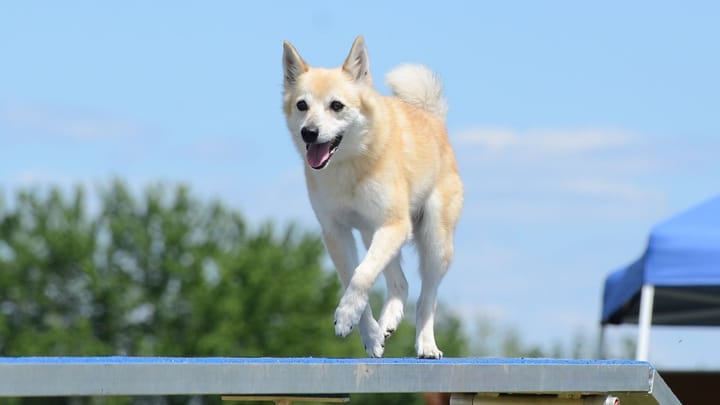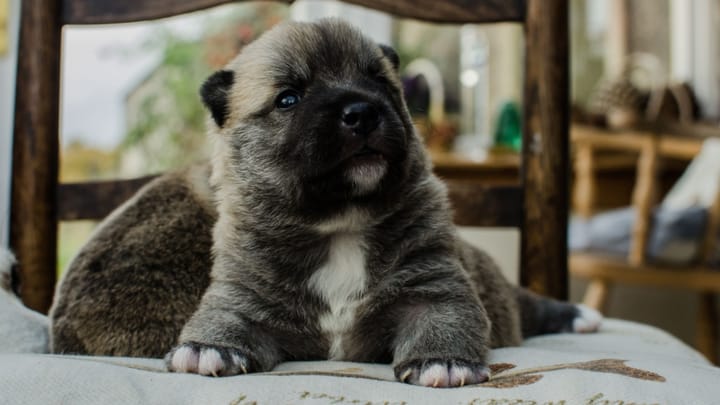Norwegian Buhund
Other names : Norsk Buhund, Norwegian Sheepdog


The name of this dog, the Buhund, is taken from the Norwegian word “Bu” which means a simple mountain hut or a homestead. This is the building where a shepherd would tend his herd. The Norwegian Buhund is a herding dog, but he also has a playful nature. He needs a great deal of daily exercise and mental stimulation. This breed does very well at agility classes as they are a great outlet for his enthusiasm and energy.
|
Life expectancy |
The Norwegian Buhund has a life expectancy of between 13 and 15 years |
|
Temperament |
|
|
Size |
Medium
|
|
Adult size |
Female
Between 16 and 18 in
Male
Between 17 and 19 in
|
|
Adult weight |
Female
Between 26 and 35 lb
Male
Between 31 and 40 lb
|
|
Coat colour
Wheaten or black. |
Black Sand |
|
Type of coat
The Norwegian Buhund breed has a dense, double coat which is very weather resistant. The dog’s undercoat is thick and soft and his top coat hard and short. |
Short Hard |
|
Eye colour
Very dark. |
Brown
|
|
Purchase price |
The Norwegian Buhund costs between £500 and £1000 |
The Norwegian Buhund breed excels at many canine activities and in their working roles. Although not too many of these dogs are used as herding dogs, they are also put to use as assistance dogs. They are also an excellent dog for canine sport competitions. If you intend to keep your dog purely as a domestic pet, you must remember that he needs to take part in sports and activities to challenge both his physical and mental health. He needs lots of outdoor exercise and long energetic walks too.
More details about the Norwegian Buhund
Norwegian Buhund: Origins and history
The Norwegian Buhund dog is from the Spitz type of canines, of which there are many variations in coat colour and size. The dog’s ancestors are from the Viking period. Indeed, remains of 6 mummified dogs were found in an excavation in Gokstad in Norway. It’s understood that the Vikings took their dogs on travels with them, and when they died, their dogs and other special possessions were buried right next to them in a tomb. The Norwegian Buhund was then used over many regions in Norway as a herding and working dog, a practice which continues to this day.
Physical characteristics of the Norwegian Buhund
With a square profile, this medium-sized Buhund dog has a wedge shaped head and a deep chest. The dog’s ears are pricked and he has a black nose. He carries his tail over the centre of his back, tightly curled.
FCI classification of the Norwegian Buhund
-
Group 5 - Spitz and primitive types
-
Section 3 : Nordic Watchdogs and Herders
Norwegian Buhund: Characteristics
Norwegian Buhund: Behaviour
Training a Norwegian Buhund
Consistent, kind training is needed for the smart Norwegian Buhund. While he is certainly capable of learning many complex commands without problems, he requires an experienced trainer to deliver this training.
Norwegian Buhund: Lifestyle
Breed compatibility Norwegian Buhund
Norwegian Buhund: Purchase price
Expect to pay between £500 to £1000 for a Norwegian Buhund dog. In addition, monthly costs to cover food, vet bills, and pet insurance will amount to between £80 to £100.
Norwegian Buhund: Grooming
This dog has a thick, harsh outer coat with a dense, soft undercoat. His coat is fairly easy to groom and brushing several times weekly should suffice.
Norwegian Buhund: Health
Generally a healthy dog breed, however as with many active dogs, he can suffer from hip dysplasia as well as hereditary eye conditions. His average life expectancy is 14 years.
A brave, bold, active and energetic dog breed.
As a native from Norway, the Buhund doesn’t do too well in warm temperatures, especially with his thick coat hair.
The Norwegian Buhund certainly tolerates the cold weather without any issues.
Some dogs are more prone to gaining weight, yet because of his high level of energy and need for vigorous exercise, this dog won’t become obese too easily.



